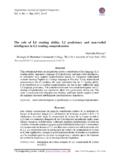Transcription of Shocks, a Mystery no More - hyperracing.com
1 Shocks, a Mystery no More Shocks, a Mystery no More by Mike Dicely Hyper Racing Inc. 1 Hyper Racing has invested thousands of hours collecting onboard shock velocity and position data and researching and developing better shock dampening profiles. You have spent and equal amount of time building, maintaining, and caring for your adrenaline fix in the garage. You owe it to yourself to understand one of the largest influences on the behavior of your car. We can sell you the right shocks, and we can teach you how and when to adjust or change them so you can travel on the lane you most want to ! With our Motec data acquisition system and through applying advanced vehicle dynamics formulas in the Motec software, we know exactly where and when the shocks are regulating massive amounts of weight.
2 The importance of shocks cannot be overstated. What is the Purpose of a Shock? One purpose of the shocks and springs is to make the chassis stable and predictable while driving over bumps or ruts. If the shock/spring combination is too stiff, the tire can be pulled off the track surface for a period of time, eliminating that tire's traction ability. If the shock/spring combination is too soft, the chassis can bottom out on the track, again hindering traction. This loss of traction in both scenarios can cause the chassis to skate and make it unpredictable and difficult to drive. A second purpose of shocks and springs is to control the amount understeer and oversteer (tightness and looseness) present in a chassis at particular parts of the track. While springs influence the amount of weight on a corner and the ride heights of the car in the static state (sitting still), their contribution in the dynamic state is limited.
3 This second purpose is where we need to spend some on. Shock Basics Before we dive into the deep end, let s understand some basic concepts and terms. Shock Terminology Dampening or damping or dampen means to depress, reduce or lessen. These terms can be used interchangeably. A shock reduces the amplitude of the wave the chassis creates after it hits a bump in the track. If a car had no shocks, it would oscillate for a long time. Compression is when the shock gets shorter; rebound is when the shock gets longer. For example, when the front bumper is depressed, compression occurs, when it is released, the shocks rebound. The velocity of a shock is the speed at which it is compressing or rebounding. It is usually referred to in terms of inches per second or in/sec. Shocks have different dampening forces at different velocities.
4 Shock Dyno Graph We are able to know the dampening forces of our shocks at different velocities by analyzing them on a Shocks, a Mystery no More Shocks, a Mystery no More by Mike Dicely Hyper Racing Inc. 2 shock dyno. Hyper s roehrig shock dyno is the best in the business. The dyno has a load cell at the top that very accurately measures the forces of the shock as a servo motor turns a crank that oscillates the shock. The servo motor can spin very accurately at different speeds enabling us to record the forces at high and low velocities. We can then view a graph of these forces known as a velocity vs. force graph. There are other graphs that can be viewed, but this is the most common. Figure 1 Shocks, a Mystery no More Shocks, a Mystery no More by Mike Dicely Hyper Racing Inc.
5 3 The Figure 1 graph shows velocity in inches per second on the X axis (horizontal) and force in pounds on the Y axis (vertical). The negative numbers (lower part of the graph) appear when the shock is in rebound, the positive numbers are compression. Figure 2 Shocks, a Mystery no More Shocks, a Mystery no More by Mike Dicely Hyper Racing Inc. 4 Figure 3 The multiple lines on the negative side of Figure 2 represent each turn of the shock adjuster of this adjustable rebound or tie down shock. In this case each line represents one turn change on the shock adjuster knob. Figure 3 is an adjustable compression shock. Be careful when reading a shock dyno graph, not all software will print the graphs the same. Some shock builders prefer the rebound side of the graph to be on the top and the compression on the bottom, this is the way ARS prints out their graphs.
6 Hyper Racing on the other hand prints them out as you see here, the rebound is on the bottom. It really makes no differnce, just look for the negative numbers and that is the rebound side. I was just always tought in class that the negative numbers run down the page and positive numbers go up the page. So this just looks right to me. Also you want to pay attention to the scale of the graph, the scale can make the graph look completely different. Pay attention to the highest velocity ( X scale, notations running along the bottom of the page) and the highest force (Y scale, the notations going up the side of the page). Shock Number Rating System Shocks, a Mystery no More Shocks, a Mystery no More by Mike Dicely Hyper Racing Inc. 5 Almost all shock companies use the force dampening at 3 in/sec velocity to rate their shocks and to apply a valving number to that shock.
7 Below is a chart of what ARS uses to rate their shocks. It gives a general idea of what forces a particular shock will yeild at 3 in/sec, it is not a hard and fast chart and should only be used as a guideline. # of valving Rebound Compression 10-20 10-20 1 20-33 20-33 2 34-45 34-43 3 46--55 44-50 4 56-70 51-65 71-85 66-75 5 86-100 76-90 101-120 91-100 6 121-135 101-115 136-155 116-135 7 156-170 136-150 The adjustable compression shock graph on the previous page is a 5 Which is a 5 rebound with a to 1 adjustable compression valved shock. The shock valving number only describes the 3in/sec else. This number really has to be taken with a grain of salt because it totally ignores everything else about the shock dampening curve. But it is a simple easy to understand way of describing a shock that most people can use without getting to confused, so I guess we will continue using it.
8 Weight Transfer Due to Shock Force To understand how the shocks affect car handling, you need to read the article called Rethink Dirt on the Hyper Racing website. It is located in Tech Department/Chassis Setup/Rethink Dirt-Advanced Theory. How do rebound and compression dampening forces influence the amount of weight on a corner? Every time the car moves as a result of a bump, wing force, or G force from lateral or longitudinal acceleration, the shock will influence the weight transfer on that corner of the car. In almost all cases the force form the shocks is much greater than the force form the spring and it will control more weight than the static weight. If we add more rebound dampening force to a shock on a particular corner of a car it will cause that corner of the car to have less weight on it when that shock is in the rebound state.
9 Conversely if we reduce rebound it will place more weight on that corner when in rebound. This is not something I made up; this is fact and is documented in every notable shock book. this means when you add rebound dampening force to your left rear shock, it is going to give the car less left rear weight. Shocks, a Mystery no More Shocks, a Mystery no More by Mike Dicely Hyper Racing Inc. 6 Think in corners here, for example, when we add rebound to the left front, we are going to add left rear right front weight when the left front shock is in the rebound state. This will tighten the car in the lateral considerations, but may loosen the car for longitudinal acceleration due to the fact that it is going to keep the CGH lower. These are the thought process you have to go through when you make a change.
10 It is rarely straight forward, one change will have many consequences. More compression dampening force of a shock will cause that corner of the car to have more weight on it while that corner is in the compression state. Less compression will place less weight on that corner when it is in compression. You can use this knowledge along with knowing how the car moves through a turn in the winged down phase and the roll right phase to figure out how the shocks are influencing the cars ride height, and corner weight. Remember it is only CGH and tire loading, trying to keep the weight equal on the rear tires, that we are affecting here. All adjustments come down to this. You can see by the shock dyno graphs that the faster a shock is moving the more force it is applying. Since we have done tons of real world testing with data acquisition sampling the shocks position 1000 times per second, I can tell you that shocks contribute a lot more to the corners weight when in motion than turns in a torsion bar stop or coil over adjuster nut.




